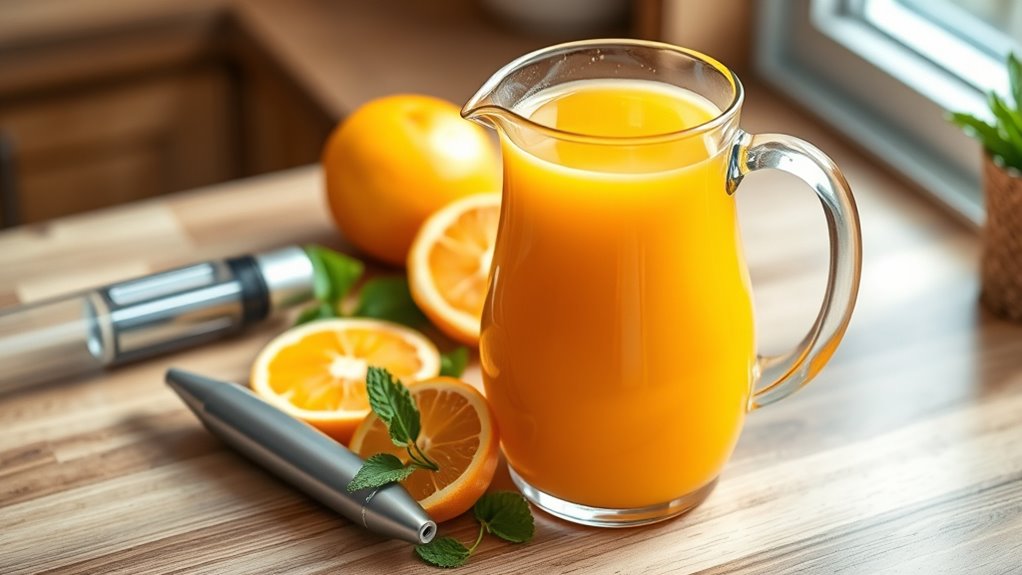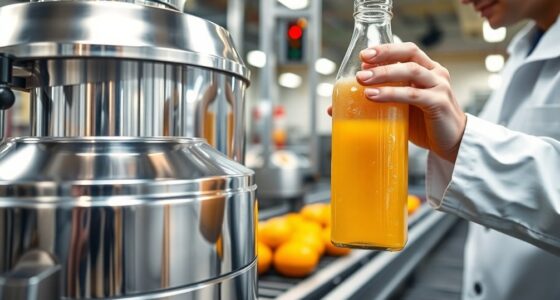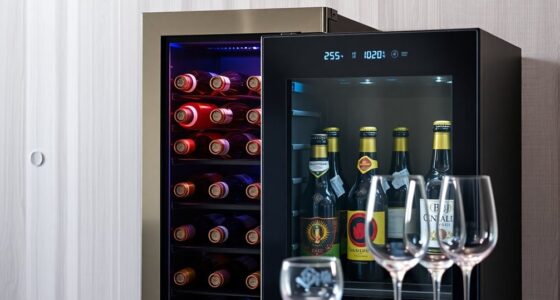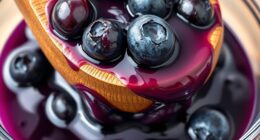To prevent oxidation in high-vitamin C juices, store them in airtight, dark containers to limit air and light exposure. Keep the juice refrigerated at low temperatures and handle it quickly to minimize oxygen contact. Adding natural antioxidants like plant extracts can also help protect vitamin C. Using freshly made juice and efficient packaging methods further extend freshness. Keep these tips in mind, and you’ll discover more ways to maximize vitamin C retention.
Key Takeaways
- Store juices in airtight, dark, UV-protected containers at low temperatures (0–4°C) to slow oxidation.
- Minimize exposure to oxygen by filling containers fully and sealing lids tightly after each use.
- Incorporate natural antioxidants like plant extracts or essential oils to inhibit oxidative reactions.
- Use fresh, high-quality produce and process juices quickly to reduce oxygen contact and nutrient loss.
- Employ packaging methods such as vacuum sealing or oxygen barrier bottles to limit oxygen exposure during storage.
Store Juices in Airtight Containers
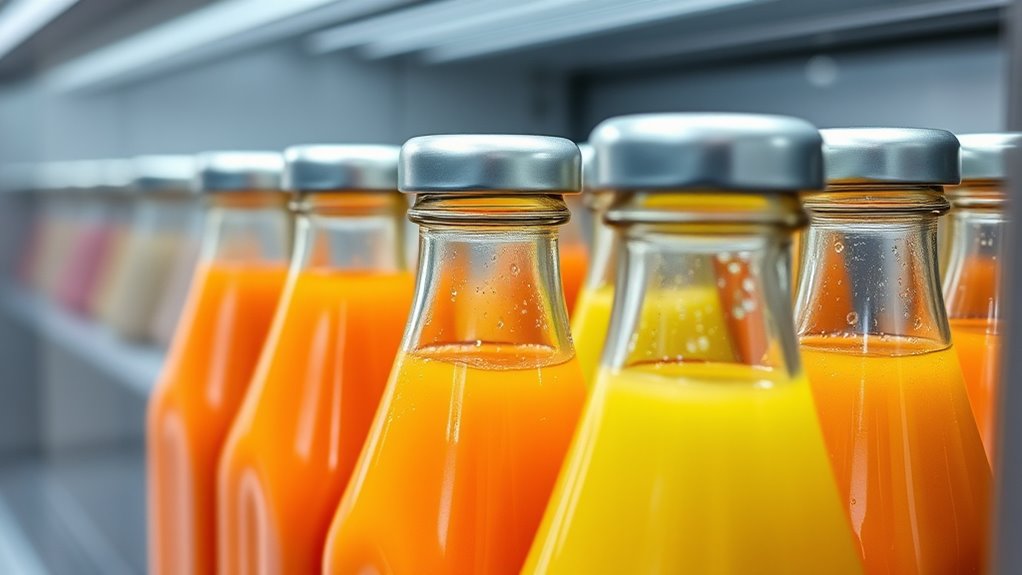
To minimize oxidation and preserve the high vitamin C content, you should always store your juices in airtight containers. Proper container sealing prevents air from coming into contact with your juice, which is essential since oxygen accelerates oxidation. Opt for airtight containers with tight-fitting lids that create an effective seal. Glass bottles or jars are ideal because they don’t react with the juice, unlike some plastics. Make sure the container is filled as much as possible to reduce air space, which helps limit oxygen exposure. Always check that the lid is securely sealed before storing. This simple step ensures your juice stays fresher longer, retains its nutritional value, and minimizes the risk of vitamin C degradation caused by oxidation. Using containers designed for oxidation prevention can further extend freshness and nutritional integrity. Additionally, selecting airtight storage solutions specifically made for perishable liquids can offer enhanced protection against oxygen exposure. Proper storage techniques are crucial to maintain the color accuracy and overall quality of your juices during storage. Incorporating proper sealing methods can further enhance the preservation process and reduce nutrient loss over time.
Use Cold Storage to Preserve Freshness
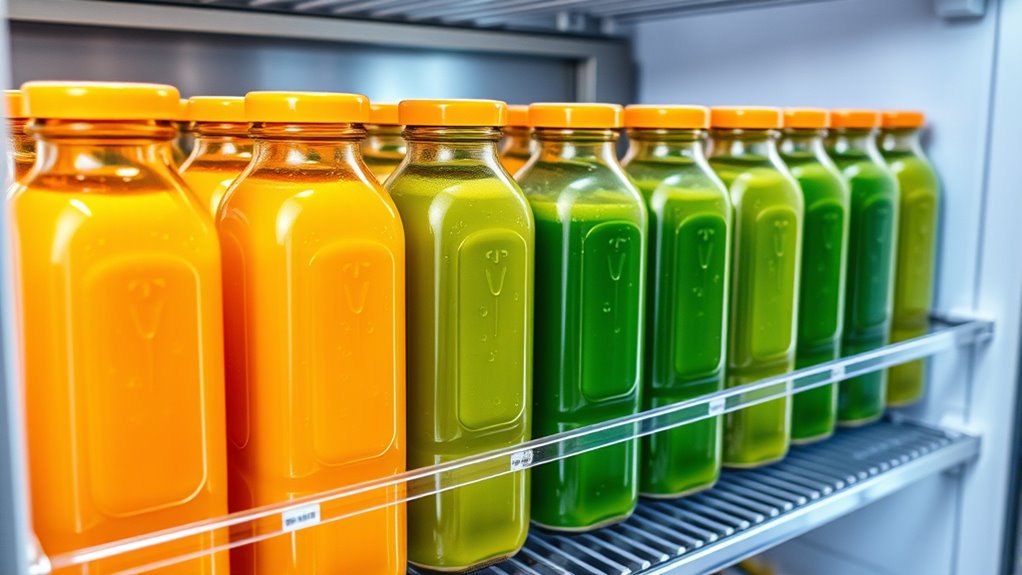
Storing your juices in a cool environment considerably slows down the oxidation process, helping to keep them fresh and nutrient-rich longer. Temperature control is essential—keep your juices at consistent, low temperatures to prevent rapid spoilage. Use refrigeration or cold storage units that maintain stable temperatures, ideally between 0°C and 4°C. Packaging materials also play an important role; choose airtight, insulated containers that minimize temperature fluctuations and block heat transfer. Avoid leaving juices out at room temperature for extended periods, as warmth accelerates oxidation. Proper cold storage not only preserves the vibrant color and flavor but also helps retain high vitamin C levels. Proper storage techniques can significantly extend the shelf life of your juice and maintain its nutritional quality. Additionally, understanding the role of AI in food science can open new avenues for improving preservation methods and ensuring product safety. Implementing temperature monitoring systems can further optimize storage conditions and prevent unexpected spoilage. Incorporating advanced preservation technologies such as modified atmosphere packaging can also provide additional protection against oxidation and spoilage.
Limit Exposure to Light and Air
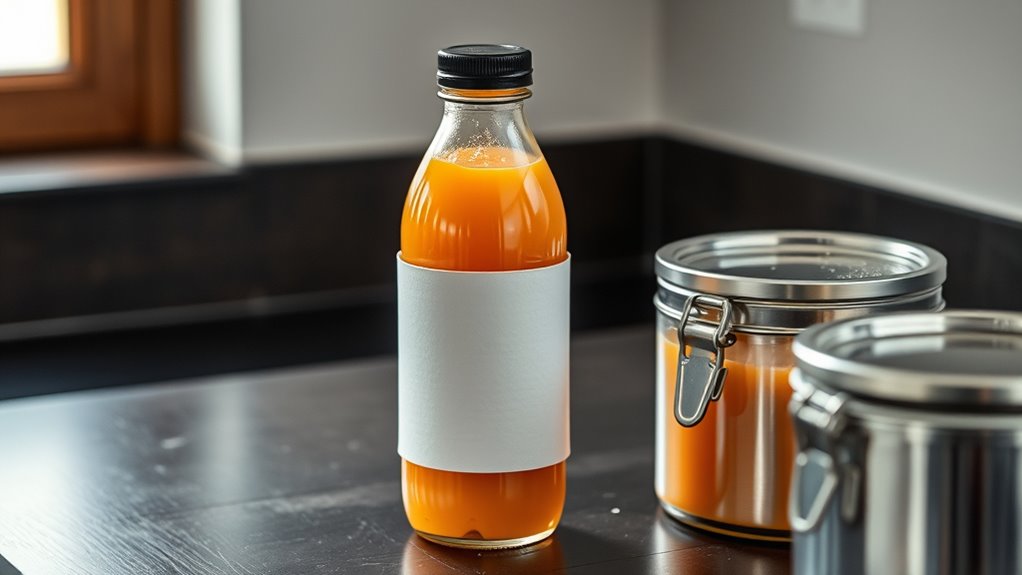
Exposure to light and air can rapidly degrade the vitamin C content and quality of your high-vitamin C juices. To prevent this, implement effective light shielding by storing your juices in dark, opaque containers that block out harmful rays. Using airtight bottles or jars helps with air exclusion, reducing oxidation caused by oxygen exposure. Keep containers sealed tightly after each use to minimize contact with air. When pouring or transferring juice, do so quickly to limit exposure. Store your juices in a cool, dark place to further protect against light-induced degradation. Proper storage techniques are essential in maintaining the freshness, potency, and nutritional value of your high-vitamin C juices over time. Ensuring that containers are airtight and sealed prevents oxygen from entering and helps preserve vitamin C levels. Regularly checking the UV light functionality of your storage containers can also help guard against light-induced nutrient loss. Additionally, using appropriate storage materials that do not react with acids found in citrus juices can further help maintain quality. Selecting containers with UV protection can provide an extra layer of defense against light damage. These simple steps—light shielding and air exclusion—are essential in maintaining the freshness, potency, and nutritional value of your high-vitamin C juices over time.
Add Natural Preservatives or Antioxidants
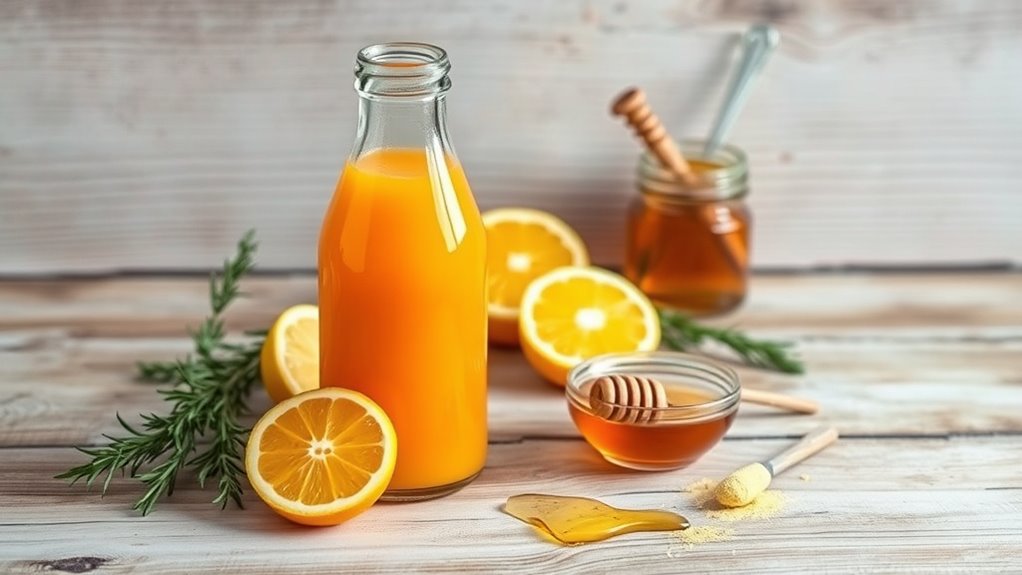
Adding natural preservatives or antioxidants can considerably boost your juice’s resistance to oxidation. You need to select these options carefully to ensure they effectively extend freshness without altering flavor. When chosen wisely, they help preserve the high vitamin C content and maintain quality longer.
Enhance Preservation Effectiveness
To improve the preservation of high‑Vitamin C juices, incorporating natural preservatives or antioxidants can be highly effective. Using innovative packaging, like oxygen-barrier bottles or vacuum-sealed containers, reduces oxygen exposure that accelerates oxidation. Additionally, pH balancing plays a vital role; maintaining a slightly acidic pH slows down enzymatic activity and preserves vitamin stability. Natural preservatives such as plant extracts or certain essential oils can complement these methods, providing extra protection without synthetic additives. Combining innovative packaging with proper pH control creates a more robust barrier against oxidation, extending shelf life. Implementing time zone information in your storage or distribution process can also help coordinate optimal preservation steps across different regions. This integrated approach not only enhances preservation effectiveness but also aligns with sustainable practices that promote environmental responsibility, keeps your juice fresher longer, and maintains its nutritional value and flavor integrity. Additionally, employing advanced preservation techniques can further improve shelf life and product quality.
Choose Natural Antioxidants Wisely
Choosing the right natural antioxidants is essential for effectively preserving high‑Vitamin C juices. Botanical extracts like green tea or rosemary provide potent antioxidant properties, helping to slow oxidation without synthetic additives. Mineral compounds such as selenium and zinc also play a crucial role in protecting the juice’s stability by supporting enzymatic defense systems. When selecting natural preservatives, consider their compatibility with your juice’s flavor profile and shelf life requirements. Be cautious of overusing certain botanical extracts, as they might alter taste or introduce unwanted compounds. Combining botanical extracts with mineral compounds can enhance antioxidant effectiveness, giving your juice a longer shelf life while maintaining its nutritional quality. Additionally, understanding conflict resolution skills can help address potential issues during production or storage, ensuring the integrity of your high‑Vitamin C juices over time. Incorporating proper handling techniques during processing and storage can further minimize oxidation and preserve the juice’s freshness. Always verify the purity and source of these natural ingredients to ensure safety and efficacy.
Minimize Processing and Handling Time

Have you ever wondered how processing and handling times affect the stability of high-vitamin C juices? The longer the juice is exposed, the more oxidation catalysts and enzymes activate, increasing the risk of nutrient loss. To minimize this, you should:
- Streamline processing to reduce exposure to oxygen and light
- Use effective enzyme inhibitors to slow oxidation reactions
- Keep handling times as short as possible to limit contact with air
- Incorporate proper storage techniques to further protect against nutrient degradation. Implementing data-driven strategies can help monitor and improve preservation methods, ensuring maximum nutrient retention. Utilizing electric bikes for transportation can also reduce delays and exposure during distribution, further protecting juice quality. Additionally, controlling oxygen levels during processing can significantly decrease oxidation rates and extend shelf life. Understanding oxidation mechanisms allows for more targeted approaches to preserve vitamin C content.
Opt for Freshly Made Juices Whenever Possible
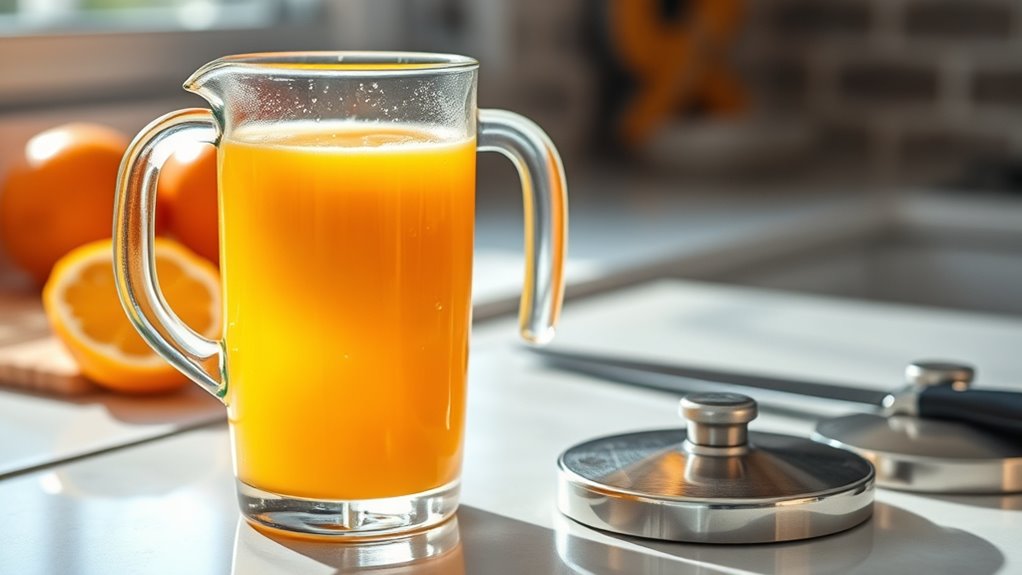
Minimizing processing and handling time helps preserve vitamin C by limiting exposure to oxidation factors. When you choose freshly made juice, you maximize its nutrient content and extend its shelf life. Fresh juice contains higher vitamin C levels because it hasn’t undergone extensive processing that can degrade nutrients. The quicker you consume it, the better its antioxidant properties. To illustrate, consider the differences:
| Fresh Juice | Packaged Juice | Shelf Life |
|---|---|---|
| Higher vitamin C | Slightly lower | Shorter, a few days |
| Best flavor | Preserved longer | Up to several weeks |
| Minimal processing | More handling | Longer storage |
Opting for freshly made juice ensures you get the highest vitamin C quality, making it a smarter choice for your health.
Frequently Asked Questions
How Does Oxidation Affect the Nutritional Value of High‑Vitamin C Juices?
Oxidation reduces the nutritional value of high-vitamin C juices by causing antioxidant degradation, which diminishes their health benefits. When exposed to air, light, or heat, vitamin C breaks down, leading to nutrient loss. This process not only weakens the juice’s antioxidant power but also lessens its overall nutritional content. To enjoy maximum benefits, you should store your juice properly, minimizing exposure to oxygen and light.
Can Certain Packaging Materials Prevent Oxidation More Effectively?
Did you know your choice of packaging can really make a difference? Certain materials act as better packaging barriers, effectively blocking oxygen and light that cause oxidation. You’ll find that materials like opaque or vacuum-sealed packaging are more effective in preserving high-vitamin C juices. By selecting packaging with superior material effectiveness, you help keep your juice fresh and nutrient-rich longer, ensuring you enjoy maximum health benefits with every sip.
Are There Specific Natural Preservatives Best Suited for High‑Vitamin C Juices?
You should consider natural antioxidants like rosemary extract or vitamin E to preserve high-vitamin C juices. These natural preservatives help prevent oxidation and extend shelf life. Additionally, employing proper storage techniques, such as keeping juices in cool, dark places and using airtight packaging, further minimizes oxidation risks. Combining natural antioxidants with effective storage methods guarantees your juice retains its nutritional value and freshness longer.
What Are the Signs That a Juice Has Oxidized or Spoiled?
When your juice has oxidized or spoiled, you’ll notice a color change, often turning dull or brownish, and an aroma shift that may smell sour or off. You might also see a cloudy or separated appearance, and the taste can become bitter or stale. These signs indicate the juice’s freshness has declined, so it’s best to discard it to avoid consuming spoiled or oxidized liquid.
How Does Temperature Influence the Rate of Oxidation in Juices?
Temperature control plays a vital role in managing oxidation in juices. When you keep your juice cold, enzymatic activity slows down, reducing the oxidation rate. Conversely, higher temperatures accelerate enzyme actions, increasing oxidation and spoilage risk. By maintaining a consistent, low temperature, you help preserve juice freshness and vitamin C content longer. Always refrigerate your juice promptly and avoid exposing it to warm environments to minimize oxidation.
Conclusion
By storing your juices in airtight containers, keeping them cold, and limiting their exposure to light and air, you protect their vibrant color, fresh flavor, and high vitamin C content. Adding natural preservatives or antioxidants further safeguards against oxidation, while minimizing processing preserves their natural goodness. Whenever possible, choose freshly made juices to enjoy maximum freshness. By following these simple steps, you guarantee your high-vitamin C juices stay flavorful, nutritious, and full of life from the first sip to the last.
Susannah expertise lies in researching and compiling evidence-based content on juicing, nutrition, and overall health. She is committed to ensuring that The Juicery World offers accurate, up-to-date, and trustworthy information to empower readers to take control of their health. Susannah’s goal is to inspire individuals to embrace juicing as a way to nourish their bodies and live their best lives.

